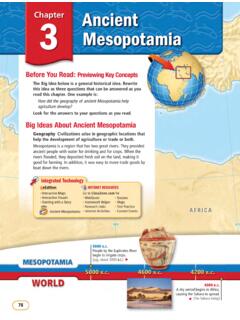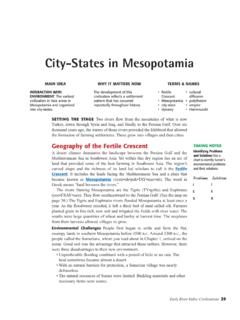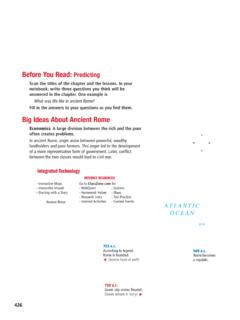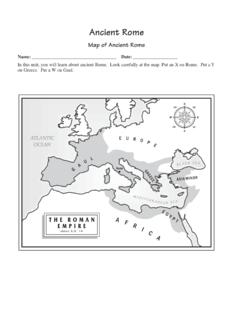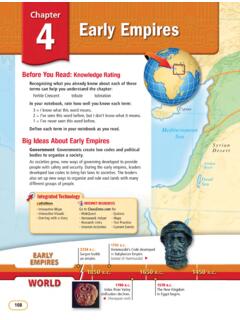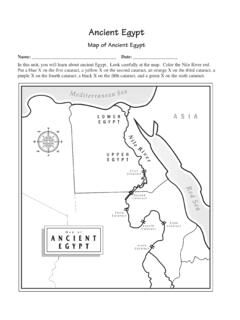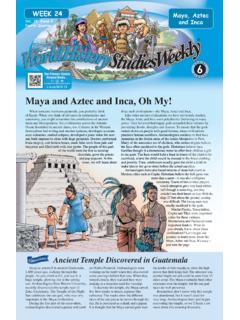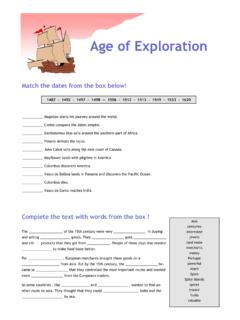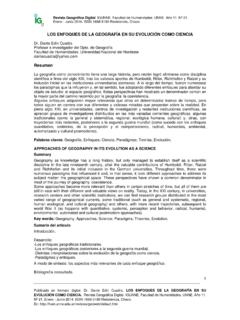Transcription of City-States in Mesopotamia - 6th Grade Social Studies
1 1. City-States in Mesopotamia MAIN IDEA WHY IT MATTERS NOW TERMS & NAMES. INTERACTION WITH The development of this Fertile cultural ENVIRONMENT The earliest civilization reflects a settlement Crescent diffusion civilization in Asia arose in pattern that has occurred Mesopotamia polytheism Mesopotamia and organized repeatedly throughout history. city -state empire into City-States . dynasty Hammurabi SETTING THE STAGE Two rivers flow from the mountains of what is now Turkey, down through Syria and Iraq, and finally to the Persian Gulf. Over six thousand years ago, the waters of these rivers provided the lifeblood that allowed the formation of farming settlements.
2 These grew into villages and then cities. Geography of the Fertile Crescent TAKING NOTES. Identifying Problems A desert climate dominates the landscape between the Persian Gulf and the and Solutions Use a Mediterranean Sea in Southwest Asia. Yet within this dry region lies an arc of chart to identify Sumer's land that provided some of the best farming in Southwest Asia. The region's environmental problems curved shape and the richness of its land led scholars to call it the Fertile and their solutions. Crescent. It includes the lands facing the Mediterranean Sea and a plain that became known as Mesopotamia (MEHS uh puh TAY mee uh).
3 The word in Problems Solutions Greek means land between the rivers. 1. 1. The rivers framing Mesopotamia are the Tigris (TY grihs) and Euphrates 2. 2. (yoo FRAY teez). They flow southeastward to the Persian Gulf. (See the map on 3. 3. page 30.) The Tigris and Euphrates rivers flooded Mesopotamia at least once a year. As the floodwater receded, it left a thick bed of mud called silt. Farmers planted grain in this rich, new soil and irrigated the fields with river water. The results were large quantities of wheat and barley at harvest time. The surpluses from their harvests allowed villages to grow.
4 Environmental Challenges People first began to settle and farm the flat, swampy lands in southern Mesopotamia before 4500 Around 3300 , the people called the Sumerians, whom you read about in Chapter 1, arrived on the scene. Good soil was the advantage that attracted these settlers. However, there were three disadvantages to their new environment. Unpredictable flooding combined with a period of little or no rain. The land sometimes became almost a desert. With no natural barriers for protection, a Sumerian village was nearly defenseless. The natural resources of Sumer were limited.
5 Building materials and other necessary items were scarce. Early River Valley Civilizations 29. C. a The Fertile Crescent, 2500 Present-day Persian Gulf sp 40 N. ia 50 E. 40 E. n 30 E. Se A N A T O L I A IRAQ. a IRAN. S MT S. T A U RU M E. S ZA. Ti Eu O GR KUWAIT. gr Mediterranean ph P. O. is ra O S. Sea te Ri s T M. ve A O SAUDI ARABIA. U. r ve M. Ri r N. IA TA. Sumer SYRIAN IN. Fertile Crescent DESERT Agade AKKAD S. Direction of flow of the Tigris and Babylon Kish Jordan River In 2500 , the Persian Gulf Euphrates Umma SUMER. Dead Lagash was larger than it is today.
6 Pe Sea Uruk Over time the Tigris and 30 N. rs Ur Euphrates have joined together ia E G Y P T. and filled in this shallow area. n ul G. ARABIAN DESERT The ancient coastline is shown ver f above with a blue line. N il e Ri Re 0 250 Miles d Se 0 500 Kilometers a GEOGRAPHY SKILLBUILDER: Interpreting Maps 1. Location Where are the Tigris and Euphrates River valleys found? 2. Place What is the most likely cause of the change in the Persian Gulf coastline? Solving Problems Through Organization Over a long period of time, the people of Sumer created solutions to deal with these problems.
7 To provide water, they dug irrigation ditches that carried river water to their fields and allowed them to produce a surplus of crops. For defense, they built city walls with mud bricks. Sumerians traded their grain, cloth, and crafted tools with the peoples of the mountains and the desert. In exchange, they received raw materials such as stone, wood, and metal. These activities required organization, cooperation, and leadership. It took many people working together, for example, for the Sumerians to construct their large Summarizing irrigation systems.
8 Leaders were needed to plan the projects and supervise the dig- What are three solutions to the ging. These projects also created a need for laws to settle disputes over how land environmental and water would be distributed. These leaders and laws were the beginning of challenges of organized government and eventually of civilization. Mesopotamia ? Sumerians Create City-States The Sumerians stand out in history as one of the first groups of people to form a civilization. As you learned in Chapter 1, five key characteristics set Sumer apart from earlier human societies: (1) advanced cities, (2) specialized workers, (3) com- plex institutions, (4) record keeping, and (5) improved technology.
9 All the later peoples who lived in this region of the world built upon the innovations of Sumerian civilization. 30 Chapter 2. By 3000 , the Sumerians had built a number of cities, each surrounded by fields of barley and wheat. Although these cities shared the same culture, they developed their own governments, each with its own rulers. Each city and the sur- rounding land it controlled formed a city -state. A city -state functioned much as an independent country does today. Sumerian City-States included Uruk, Kish, Lagash, Umma, and Ur. As in Ur, the center of all Sumerian cities was the walled temple with a ziggurat in the middle.
10 There the priests and rulers appealed to the gods for the well-being of the city -state. Priests and Rulers Share Control Sumer's earliest governments were controlled by the temple priests. The farmers believed that the success of their crops depended upon the blessings of the gods, and the priests acted as go-betweens with the gods. In addition to being a place of worship, the ziggurat was like a city hall. (See page 22 for a ziggurat.) From the ziggurat the priests managed the irrigation system. Priests demanded a portion of every farmer's crop as taxes.
